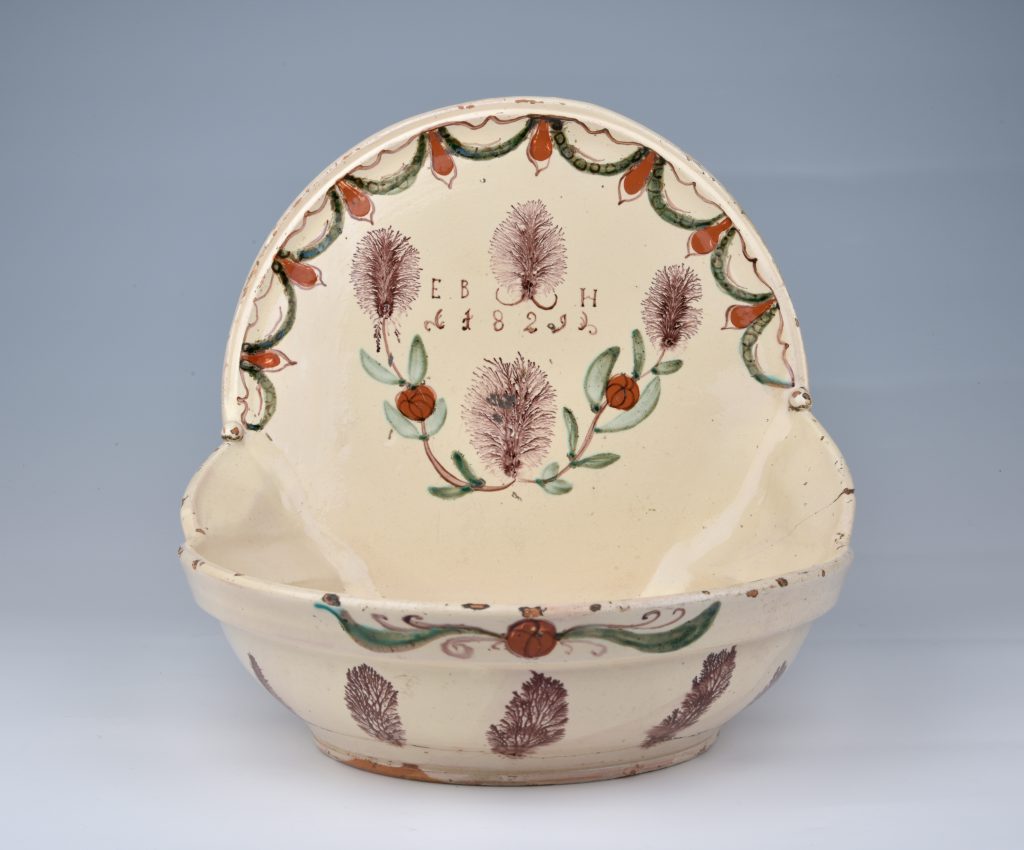
Dendritic decoration in CERAMICA CH
Andreas Heege, Pierre-Yves Tribolet 2019
The term ‘dendritic decoration’ comes from the Greek word for tree, “dendros”, and describes the decoration, which looks like a plant or small tree. In England and the United States, the decoration is known as ‘mocha’ or ‘mocha ware’ (Brooks 2005, 40; Rickard 1993; Rickard 2006). The term ‘mocha’ is thought to have referred to moss agate, a rock that was similar in appearance and was exported from the Yemeni port city of Mokha. In France, the decoration is known as “décor herborisé”, “décor d’herborisation” or “deuil à la Reine” [mourning for the queen] (Maire 2008, 50 and 278–281). The term “deuil à la Reine” came from the belief that the decoration was created during the Bourbon Restoration in memory of Louis XVI and Marie Antoinette and that the portraits of the King and Queen were concealed in the dendritic motifs, which in turn were interpreted as weeping willows (Blondel 2001, 226).
Another term that is often used is ‘mocha diffusion’. This term derives from the chemical reaction that is at the core of the technique. It involves drizzling, brushing or spraying an acidic colour mixture onto a wet slip. As soon as the colour mixture comes into contact with the slip, which forms an alkaline base, it starts branching out to form the dendritic pattern (Storr-Britz 1977, 128; Storr-Britz 1982, 93; Blondel 2001, 226; Maire 2008, 278–281). A wide range of acidic solutions are used, which contain vinegar/apple cider vinegar, urine, tea leaves, tobacco and manganese dioxide (Hume 1969, 131; Turnbull 1974; Brooks 2005, 40).
Classic examples of refined white earthenware with dendritic decoration were originally made in England, and later also in France and Germany, and mainly bore manganese purple or black motifs, though blue and yellow patterns can also be found. While in England the production of this type of pottery appears to have begun no later than the 1790s, the earliest pieces from Montereau/Creil in France are dated to 1803/1804 (Hume 1969, 131; Rickard 1993; Carpentier/Rickard 2001, 122). It was not until the 19th century that the technique was also used to decorate earthenware from various German-speaking regions in Switzerland (e.g. in St. Antönien, Canton of Graubünden and in the Heimberg-Steffisburg region of the Canton of Bern. Heege 2010, Fig. 64,2; Heege 2012, Fig. 11,2 and Fig. 12; Heege 2016, 87–88; Roth-Rubi/Schnyder/Egger et al. 2000, Fig. 26; Stolle 1981, 47 and Cat. 221; Klein 1989, Pl. 31; Hillenbrand/Spies 1965, Pl. VIII,25; Hafnergeschirr Pustertal 2017, Cat. 167, 173).
Translation Sandy Haemmerle
Synonyms: mocha, mocha ware, seaweed decoration
German: Dendritischer Dekor, Zerfliess-Technik, Diffusions-Technik
French: décor herborisé, décor d’herborisation, deuil à la Reine
References:
Blondel 2001
Nicole Blondel, Céramique: vocabulaire technique, Paris 2001.
Brooks 2005
Alasdair Brooks, An Archaeological Guide to British Ceramics in Australia, 1788-1901, Sydney 2005.
Carpentier/Rickard 2001
Donald Carpentier/Jonathan Rickard, Slip Decoration in the Age of Industrialization, in: Ceramics in America, 2001, 115-134.
Hafnergeschirr Pustertal 2017
Dietenheim Südtiroler Landesmuseum für Volkskunde/Universität Innsbruck Institut für Archäologien (Hrsg.), Hafnergeschirr aus dem Pustertal. Formen und Dekore des 18. bis 20. Jahrhunderts (Nearchos 22), Innsbruck 2017.
Heege 2010
Andreas Heege, Keramik um 1800. Das historisch datierte Küchen- und Tischgeschirr von Bern, Brunngasshalde, Bern 2010.
Heege 2012
Andreas Heege, Drei neuzeitliche Grubeninventare von Jegenstorf, in: Archäologie Bern/Archéologie bernoise. Jahrbuch des Archäologischen Dienstes des Kantons Bern, 2012, 159-196.
Heege 2016
Andreas Heege, Die Ausgrabungen auf dem Kirchhügel von Bendern, Gemeinde Gamprin, Fürstentum Liechtenstein. Bd. 2: Geschirrkeramik 12. bis 20. Jahrhundert, Vaduz 2016.
Heege 2019
Andreas Heege, Keramik aus St. Antönien. Die Geschichte der Hafnerei Lötscher und ihrer Produkte (1804-1898) (Archäologie Graubünden – Sonderheft 7), Glarus/Chur 2019, 191-193.
Hillenbrand/Spies 1965
Karl Hillenbrand/Gerd Spies, Hafnerware in Südwestdeutschland (Der Museumsfreund. Aus Heimatmuseen und Sammlungen in Baden-Württemberg 6), Stuttgart 1965.
Hume 1969
Ivor Noël Hume, A guide to artifacts of Colonial America, Philadelphia 1969.
Klein 1989
Georges Klein, Poteries populaires d’Alsace, Strassburg 1989.
Maire 2008
Christian Maire, Histoire de la faïence fine francaise 1743-1843, Le Mans 2008.
Rickard 1993
Jonathan Rickard, Mocha Ware. Slip-decorated refined earthenware, in: Antiques, 1993, 182-189.
Rickard 2006
Jonathan Rickard, Mocha and Related Dipped Wares, 1770-1939, Hanover 2006.
Roth-Rubi/Schnyder/Egger u.a. 2000
Kathrin und Ernst Roth-Rubi/Rudolf Schnyder/Heinz und Kristina Egger u.a., Chacheli us em Bode… Der Kellerfund im Haus 315 in Nidfluh, Därstetten – ein Händlerdepot, Wimmis 2000.
Stolle 1981
Walter Stolle, Volkstümliche Keramik aus Hessen vom 18. Jahrhundert bis zur Gegenwart dargestellt an Beispielen aus Mittel- und Südhessen. Ausstellung des Hessischen Museumsverbandes 1981, Kassel 1981.
Storr-Britz 1977
Hildegard Storr-Britz, Ornamente und Oberflächen in der Keramik, Düsseldorf 1977.
Storr-Britz 1982
Hildegard Storr-Britz, Keramik dekorieren. Neue und alte handwerkliche Techniken, Ravensburg 1982.
Turnbull 1974
Margaret E. Turnbull, Mochaware in: The Antiques Journal, 1974, 42-43.

